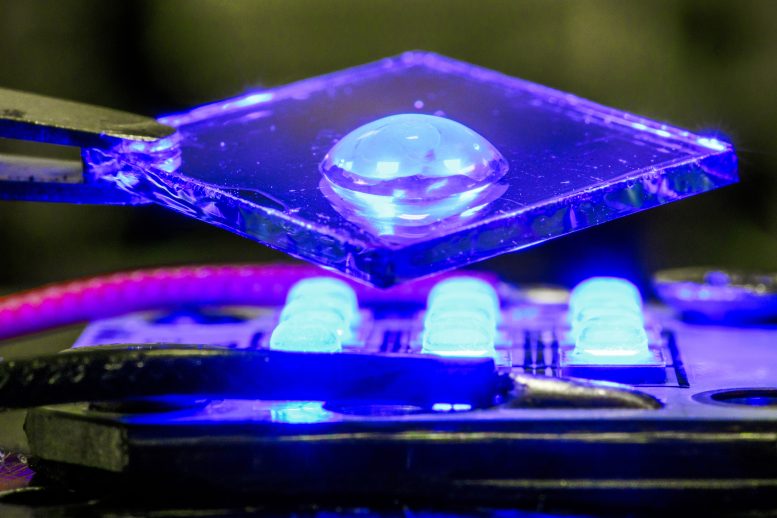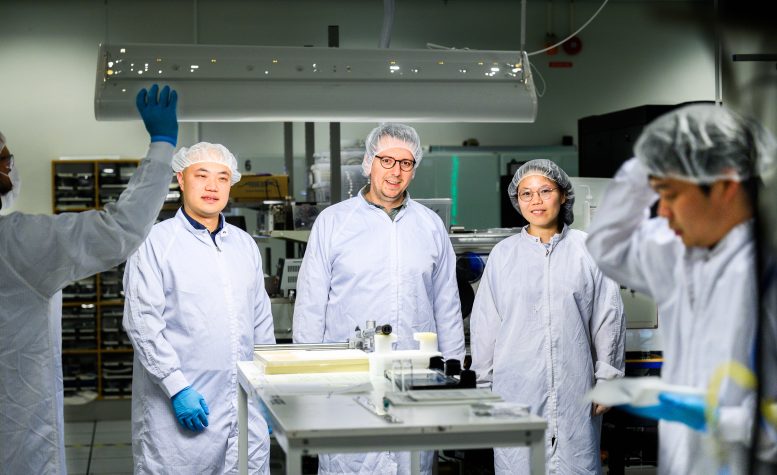
The new method involves dipping the conductive plastic into a special salt solution – a photocatalyst – and then illuminating it with light for a short time resulting in a p-doped conductive plastic in which the only consumed substance is oxygen in the air. Credit: Thor Balkhed
A new doping method uses air and light to enhance the conductivity of organic semiconductors, promising greater scalability and environmental sustainability in electronic device production.
Semiconductors are the foundation of all modern electronics. Now, researchers at Linköping University, Sweden, have developed a new method where organic

Researchers Chi-Yuan Yang, Simone Fabiano and Qingqing Wang at the Laboratory of Organic Electronics at Linköping University. Credit: Thor Balkhed
To enhance conductivity and modify semiconductor properties, so-called dopants are typically introduced. These additives facilitate the movement of electrical charges within the semiconductor material and can be tailored to induce positive (p-doping) or negative (n-doping) charges. The most common dopants used today are often either very reactive (unstable), expensive, challenging to manufacture, or all three.
Now, researchers at Linköping University have developed a doping method that can be performed at room temperature, where inefficient dopants such as oxygen are the primary dopant, and light activates the doping process.
Innovations in Doping Methods
“Our approach was inspired by nature, as it shares many analogies with 
Simone Fabiano, senior associate professor at Linköping University. Credit: Thor Balkhed
This is possible because the photocatalyst acts as an “electron shuttle”, taking electrons or donating them to material in the presence of sacrificial weak oxidants or reductants. This is common in chemistry but has not been used in organic electronics before.
“It’s also possible to combine p-doping and n-doping in the same reaction, which is quite unique. This simplifies the production of electronic devices, particularly those where both p-doped and n-doped semiconductors are required, such as thermoelectric generators. All parts can be manufactured at once and doped simultaneously instead of one by one, making the process more scalable,” says Simone Fabiano.
The doped organic semiconductor has better conductivity than traditional semiconductors, and the process can be scaled up. Simone Fabiano and his research group at the Laboratory of Organic Electronics showed earlier in 2024 how conductive plastics could be processed from environmentally friendly solvents like water; this is their next step.
“We are at the beginning of trying to fully understand the mechanism behind it and what other potential application areas exist. But it’s a very promising approach showing that photocatalytic doping is a new cornerstone in organic electronics,” says Simone Fabiano, a Wallenberg Academy Fellow.
Reference: “Photocatalytic doping of organic semiconductors” by Wenlong Jin, Chi-Yuan Yang, Riccardo Pau, Qingqing Wang, Eelco K. Tekelenburg, Han-Yan Wu, Ziang Wu, Sang Young Jeong, Federico Pitzalis, Tiefeng Liu, Qiao He, Qifan Li, Jun-Da Huang, Renee Kroon, Martin Heeney, Han Young Woo, Andrea Mura, Alessandro Motta, Antonio Facchetti, Mats Fahlman, Maria Antonietta Loi and Simone Fabiano, 15 May 2024, Nature.DOI: 10.1038/s41586-024-07400-5
Funding: Knut och Alice Wallenbergs Stiftelse, Wallenberg Wood Science Center, Wallenberg Initiative Materials Science for Sustainability, Vetenskapsrådet, Stiftelsen Olle Engkvist Byggmästare, European Commission, Swedish government’s strategic research area in advanced functional materials (AFM) at Linköping University

